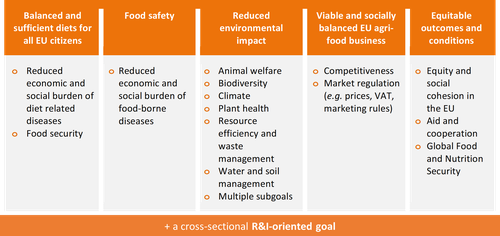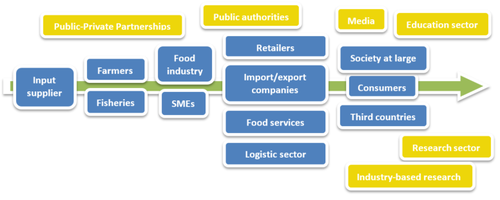Classification framework
The policies are classified in terms of goals, targets and instruments in support of the identification of policy gaps and priorities.

POLICY GOALS
Policy goals are high order statements of desired outcomes describing the fundamental outcomes that a policy aims to achieve through its activities. The adopted goals of a policy are classified according to SUSFANS conceptual framework1, slightly adjusted to reflect the desired outcomes expressed in EU or national policies which are provided in the figure (in orange):
More specifically, the chosen food policy goals are:
- Balanced and sufficient diets for all EU citizens
- Food safety
- Reduced environmental impact
- Viable and socially balanced EU agri-food business
- Equitable outcomes and conditions
- A Cross-Sectional R&I-oriented goal
Subgoals: The sub-goals of the policy according to the SUSFANS classification which are provided in the figure under each goal.
1SUSFANS (Metrics, Models and Foresight for European Sustainable Food And Nutrition Security) is a H2020 multidisciplinary research program aimed at building the conceptual framework, the evidence-based and analytical tools for underpinning EU-wide food policies with respect to their impact on consumer diet and their implications for nutrition and public health in the EU, the environment, the competitiveness of the EU agri-food sectors, and global FNS

POLICY TARGETS
Primary target: the main societal group towards which the policy action is directed or applied by the instrument used; The mapped policies refer to the entire food system: from inputs, primary production, harvesting, storage, processing, packaging and distribution, to consumers. The mapping has considered not only policies targeting actors involved in the food system, but also those targeting actors who, even if not directly involved in the food system, can influence food availability and consumption or other related matters (e.g. the logistic sector, import/export companies, the education sector, research institutions, the health sector, media and public authorities). The following primary targets are considered in the food policy classification:
- Food industry
- SMEs
- Media
- School food services
- Food services
- Education sector
- Public authorities
- Consumers
- Research sector
- Farmers
- Industry-based research
- Third countries
- Fisheries
- Input suppliers
- Import/export companies
- Logistic sector
Ultimate beneficiary: the societal group that is linked to the overall policy goal (e.g. a ban on trans-fats affects directly manufacturing companies but is intended to promote healthy eating habits among consumers, who thus are the ultimate beneficiaries). The following ultimate beneficiaries are considered in the food policy classification:
- Consumers
- Society at large
- Third countries
- Food industry
- SMEs
- Farmers
- Fisheries
- Research sector
POLICY INSTRUMENTS
Techniques or means through which public actors (e.g. national and EU government bodies, public agencies, etc.) attempt to attain their goals. The following policy instruments are considered in the food policy classification:
- Regulation and self-regulation (e.g. quality, safety or nutrition laws concerning the production and processing of food products; advertising restrictions and bans; sale restrictions; food marketing rules; regulation on health, nutrition and safety claims; GMO regulations; etc.);
- Fiscal policies (e.g. taxes or subsidies applied to certain categories of food and drink ingredients; subsidies for farmers to grow certain crops; return systems to reduce packaging waste; financial support for withdrawals of food products; tax exemptions; etc.);
- Income support measures (e.g. income-based or other conditional food vouchers or cash transfers targeting, for instance, farmers or low-income consumers), with the aim of improving their purchasing power and access to food products and/or agricultural inputs, equipment and machineries, thus helping to tackle disparities;
- Border measures (import and export licences, tariffs and quotas for certain food products; animal and animal-derived products transit rules; veterinary certifications for imports; etc.);
- Food and agricultural standards, either voluntary or mandatory, setting rules on content (ingredients) and composition of foods; use of food additives, supplement and improvement agents;
- Labelling measures, which set the type and extent of information about a product, its container or packaging that must be imparted by a label;
- Information measures (i.e. social marketing; awareness campaigns; recommendations; dedicated informative websites; knowledge transfer programmes; guidelines; etc.);
- Education measures (i.e. educational programmes on European agriculture, healthy eating addressed to pre-primary, primary, secondary and tertiary school students; the inclusion of food-related curricula or classes in schools; trainings addressed to food services personnel and staff; tailor-made advice for farmers and fishermen; etc.);
- Delivery of services (e.g. support for the internationalisation of EU agri-food businesses; common catalogues for agricultural product varieties; networks and databases to connect multiple public and private bodies; etc.);
- Procurement (i.e. government food purchases, generally for food assistance, hospitals, schools, nursing homes, prisons, the military, etc. – they are often part of public food procurement strategies to boost rural economies, promote agricultural development, encourage the development of SMEs, improve food security and nutrition, and support the achievement of social, environmental and economic objectives by linking public food purchases to domestic food production);
- SME-targeted support (i.e. guarantee funds for SMEs to promote access to funding sources; measures to regulate aid to SMEs; etc.).
- R&I, which we chose to define as a policy instrument designed to reach a given policy goal, rather than a policy target by itself. Following the classification by Rogge and Reichardt (2016), the class of R&I policy instruments has been broken down into three dimensions:
- Economic instruments (i.e. R&D grants and loans, tax incentives, state equity assistance, subsidies, feed-in tariffs, trading systems, deposit-refund-systems, public procurement, export credit guarantees, infrastructure provision, cooperative R&D grants);
- Regulation (i.e. patent law, intellectual property rights, technology/performance standards, prohibition of products/practices, application constraints, market design, grid access guarantee, priority feed-in, environmental liability law);
- Information (i.e. professional training and qualification, entrepreneurship training, scientific workshops, training on new technologies, rating and labelling programs, public information campaigns, education system, thematic meetings, public debates, cooperative R&D programs, clusters)